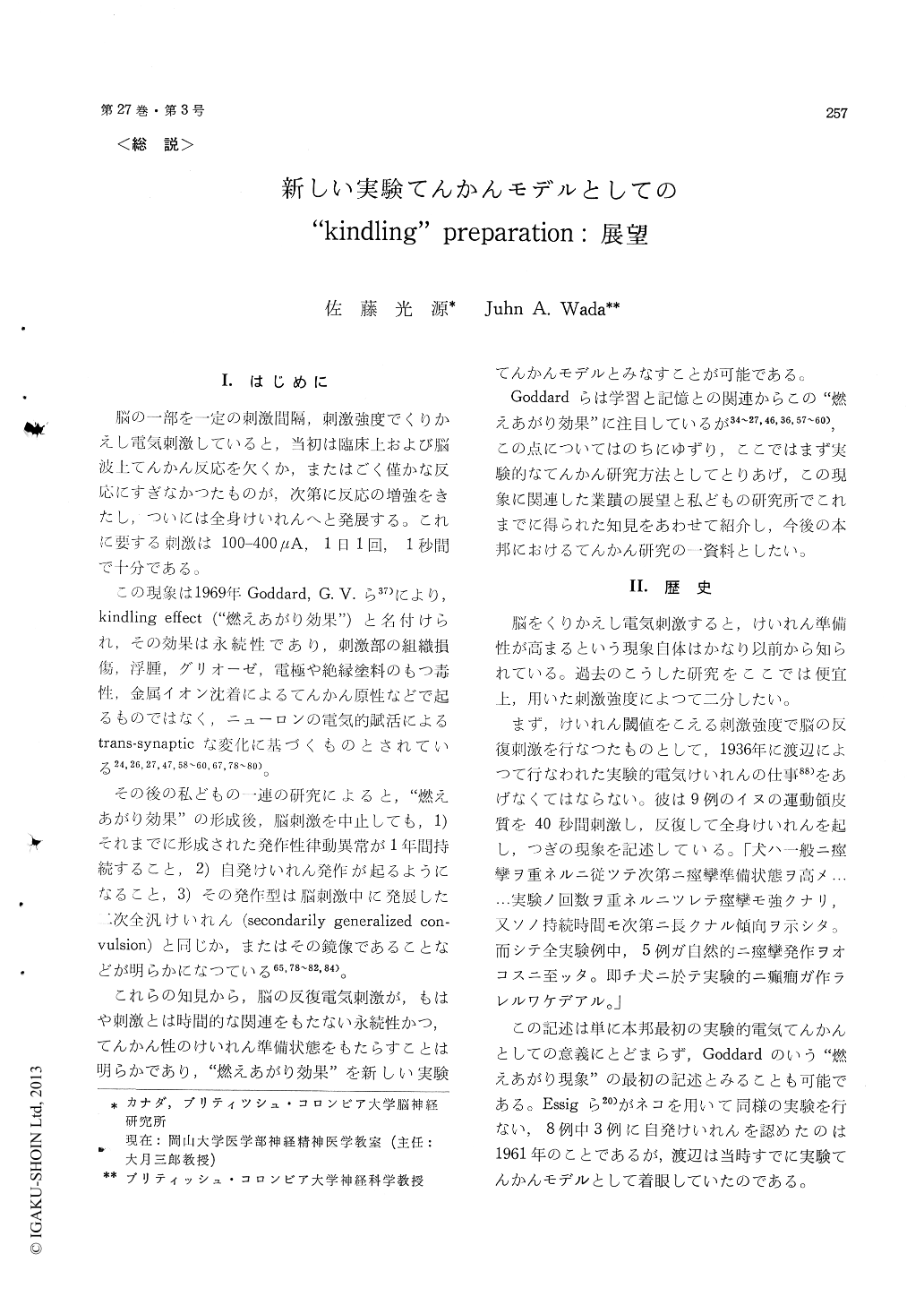Japanese
English
- 有料閲覧
- Abstract 文献概要
- 1ページ目 Look Inside
I.はじめに
脳の一部を一定の刺激間隔,刺激強度でくりかえし電気刺激していると,当初は臨床上および脳波上てんかん反応を欠くか,またはごく僅かな反応にすぎなかつたものが,次第に反応の増強をきたし,ついには全身けいれんへと発展する。これに要する刺激は100-400μA,1日1回,1秒間で十分である。
この現象は1969年Goddard,G.V.ら37)により,kindling effect ("燃えあがり効果")と名付けられ,その効果は永続性であり,刺激部の組織損傷,浮腫,グリオーゼ,電極や絶縁塗料のもつ毒性,金属イオン沈着によるてんかん原性などで起るものではなく,ニューロンの電気的賦活によるtrans-synapticな変化に基づくものとされている24,26,27,47,58〜60,67,78〜80)。
Kindling refers to Goddard's observation that initially subconvulsive electrical stimulation applied through chronic electrodes can, with repeated ad-ministration, come to evoke generalized clinical convulsive seizures in conjunction with increased propagation and complexity of electrographic seizure discharge. Kindled seizures can be developed from electrodes implanted in various subcortical and neo-cortical loci ; and kindling has been obtained in rats, cats, rabaits, and infrahuman primates. There are ample clinical evidences in the literature to suggest that patients who receive repeated electric shock treatment can develop spontaneous epileptic seizures probably based on the mechanism similar to that of kindling. The authors reviewed signi-ficant past work including their own in order to define basic conditions necessary for this phenomenon to occur. It is clear that kindling is a trans-synapticprocess that does not result from localized distur-bances produced by oedema, gliosis, poisoning, or tissue damage at the tip of the stimulating elect-rode.
Our observation in cats and subhuman primate showed that the daily electrical stimulation results in the development of an independent after-discharge as well as interictal spike discharge in the ipsi-lateral midbrain reticular formation with further involvement of the contralateral hemispheric struc-tures eventually leading to a generalized seizure state associated with bisymmetrical electrographic ictal and interictal events. This finding comple-ments our previous finding of secondary epilepto-genic functional alteration in deep structures parti-cularly extrapyramidal pathways including midbrain reticular formation both in cats and monkeys with chronic focal cortical alumina cream lesion.
Once the animals are kindled, their induced seizure susceptibility as measured by a generalized seizure triggering threshold and interictal spike discharge remained unchanged for more than 12 months with-out further stimulation, indicating the permanent nature of induced functional alteration. This is further supported by the fact that spontaneous recurrent seizures of focal onset identical to or mirror image of the kindled seizure were observed in our cats. Further observation of spontaneous recurrent clinical seizures in subhuman primates highlights the similiarities of these preparations to certain characteristics of the human epilepsies ; we believe that our ongoing comparison of amygdaloid kindling in baboons and Rhesus monkeys will have significant clinical and theoretical implications, in that the syndrome in the former is akin to primary generalized epilepsy with a presumed strong genetic predisposition, while the latter is akin to secondary generalized epilepsy with no presumed genetic pre-disposition. In other words, kindled baboons pro-gress through a stage of seizure development where the electrographic and clinical manifestations are bilateral but very definitely asymmetrical. However, our kindled baboons have progressed to an even further stage of seizure development in which the clinical manifestations become bisymmetrical and the electrographic manifestations become bisyn-chronous. It is this latter stage of seizure develop-ment that we believe reflects the baboons genetic predisposition to primary generalized epilepsy, and we predict that like kindled cats and rats, kindled rhesus monkeys will fail to develop to this stage.Similarly, our observations to date in subhuman primates strengthen our notion that vertical rather than horizontal (trans-hemispheric inter-limbic) ictal propagation is of utmost importance for the develop-ment of generalized seizure of amygdaloid origin. Taken together, these findings strongly support our notion that repeated but localized electrical brain stimulation produced a widespread secondary func-tional alteration and predictable reorganization of the brain function culminating in a permanent state of epileptogenisty strikingly reminiscent of human epilepsy. On the other hand, electrophysio-logical evidence is available to suggest that trans-mission of non-epileptic activity is altered by kind-ling. This is significant since it enables us to consider this preparation as a possible model for physiological pattern of brain function. The find-ings of amygdaloid kindling resulting in either en-hancement of its normal capacity to suppress preda-tory behavior or permanent change in conditioned emotional behavior, suggest that detailed exami-nation of underlying mechanism of kindling may allow us to obtain fair insight into the neurological basis for cerebral plasticity. Since induced brain and behavioral effects are "permanent" and asso-ciated neurobiological changes must correlate with the "predisposition to respond" (engram), and with the response itself, or any temporary after-effects of the response. Kindling is probably the only known instance where an engram can be clearly separated from activity per se. Preliminary evi-dences are available that the kindled synapses in the amygdala show an enlargement of axon termi-nals. Needless to say that the increased terminal size is not necessarily an explanation and may only be a neuroanatomical reflection of past history. Regardless of its interpretation, credit is due to Goddard who opened up the fascinating and tanta-lizing new vistas of neurobiology.
The kindling model itself is epileptiform, and investigation of its underlying mechanisms is likely to significantly contribute not only to the under-standing of human epilepsy particularly its progres-sive nature, but also to the development of strate-gies for prophylaxis as well as practical manage-ment of seizure disorder. Similarly, study using the kindling model should contribute to basic know-ledge of anatomy and physiology of brain as well as behavior correlates particularly with respect to plasticity of brain function.

Copyright © 1975, Igaku-Shoin Ltd. All rights reserved.


